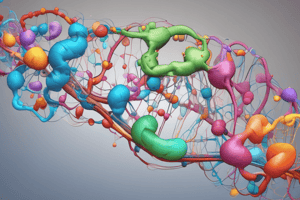Podcast
Questions and Answers
Flashcards are hidden until you start studying
Study Notes
RNA: Structure and Function
- RNA is a macromolecule closely related to DNA, playing important roles in protein synthesis, communicating cellular signals, and catalyzing chemical reactions.
- Major RNA classes include:
- Messenger RNA (mRNA): carries information about a protein sequence to the ribosomes; synthesized inside the nucleus; a group of 3 nucleotides in mRNA makes up a codon.
- Ribosomal RNA (rRNA): comprises the majority of RNA found in typical eukaryotic cells; catalytic component of the ribosome; combines with proteins to form the ribosome.
- Transfer RNA (tRNA): small RNA with approximately 80 nucleotides; transfers amino acids to growing polypeptide chains at the ribosomal site of protein synthesis; important regions include the anticodon (complementary to the codon in mRNA) and the site for amino acid attachment.
Central Dogma of Molecular Biology
Replication
- Process that synthesizes DNA by copying existing DNA; occurs in the nucleus during the Synthesis Phase of the cell cycle prior to cell division.
- Models of DNA replication include:
- Conservative Model: the two parental DNA strands separate and act as templates for the synthesis of new DNA strands; the two parental strands re-pair or reassociate after acting as templates.
- Semiconservative Model: the two parental DNA strands separate and act as templates for the synthesis of new DNA strands; the two parental strands do not re-associate; supported by the experiment of Matthew Meselson and Franklin Stahl.
- Dispersive Model: each strand of both daughter molecules contains a mixture of old and newly synthesized DNA.
- Proteins required for replication include:
- Helicase: unwinds DNA strands apart ahead of the DNA polymerase.
- Topoisomerase: relieves torsional stress ahead of the replication fork.
- Primase: copies a DNA template strand by making an RNA strand complementary to it.
- DNA polymerase III: major polymerizing enzyme that catalyzes the formation of phosphodiester bonds (in the presence of an RNA primer).
- Single-strand DNA-binding protein: binds single-stranded DNA, keeping them from re-associating.
- DNA polymerase I: enzyme with exonuclease function (removes RNA primers) and polymerase function (replaces primers with deoxynucleotides).
- DNA ligase: catalyzes covalent joining of the lagging strand pieces.
Transcription
- Synthesis of RNA molecules, particularly mRNA, using dsDNA as the template.
- Occurs inside the nucleus.
- Involves three stages: initiation, elongation, and termination.
Studying That Suits You
Use AI to generate personalized quizzes and flashcards to suit your learning preferences.




